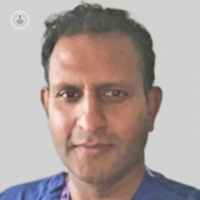How is an abdominal wall reconstruction performed?
Written by:Are you preparing for an upcoming abdominal wall reconstruction and are seeking more information regarding the procedure? If so, then our latest article may have all those key nuggets of detail that you’re seeking. Esteemed consultant general, vascular, and paediatric surgeon, Mr Rame Sunthareswaran, is the expert to share his insights into abdominal wall reconstruction.

What does an abdominal wall reconstruction involve?
This is, essentially, a way of fixing a complex abdominal wall hernia, as a consequence of a failed previous repair. It involves deconstructing the layers of the abdominal wall, and then putting them back together again, usually with the supplementation of a mesh, which acts as a scaffold to help the body to reinforce and strengthen after the operation.
Why might people require an abdominal wall reconstruction?
Patients who have quite a complex defect within their abdominal wall would require it. Most patients with abdominal wall hernias do tend to suffer from pain, bowel problems that can lead to serious complications further down the line, and problems related to the abdominal wall not functioning properly.
Added strain on the back is also a common reason why an abdominal wall reconstruction might be required, as the back can certainly be affected by the abdominal wall’s inability to function correctly.
Who is the ideal candidate for this procedure?
Not all patients are suitable for an abdominal wall reconstruction. Patients who have previously undergone a failed abdominal wall reconstruction would be ideal. People who smoke and who are obese are not as suitable for this procedure.
How long is the procedure and what does recovery time look like for patients?
It depends on the complexity and the repair. It would typically last between two to four hours. Most patients are inpatients and may be in hospital for anywhere between three to five days.
Why might this surgical intervention be complex?
The continuity of the muscle and layers in the abdominal wall needs to be able to perform a durable repair. It may require things to be undertaken preoperatively to facilitate the repair.
It is an extensive surgery. One might need to reduce the risk of nerve damage and bleeding, as these are commonly associated risks.
What would be your post-operative advice for patients who have had an abdominal wall reconstruction?
Initial recovery is gradual. Pain and discomfort can be controlled with painkillers. It is important to avoid any heavy lifting for at least six weeks. You will need to do some structured exercises to get your muscles adjusted to this new feeling.
Mr Rame Sunthareswaran is a highly esteemed consultant general, vascular, and paediatric surgeon who possesses a high level of expertise in abdominal wall reconstruction surgery.


